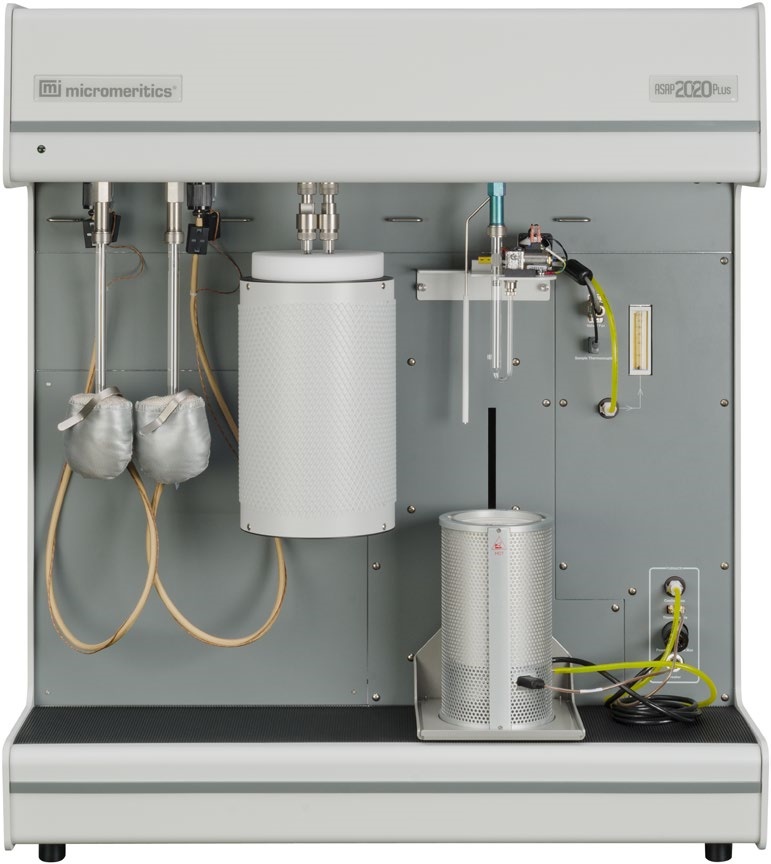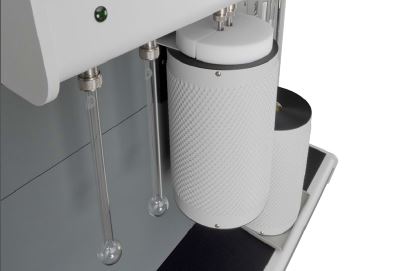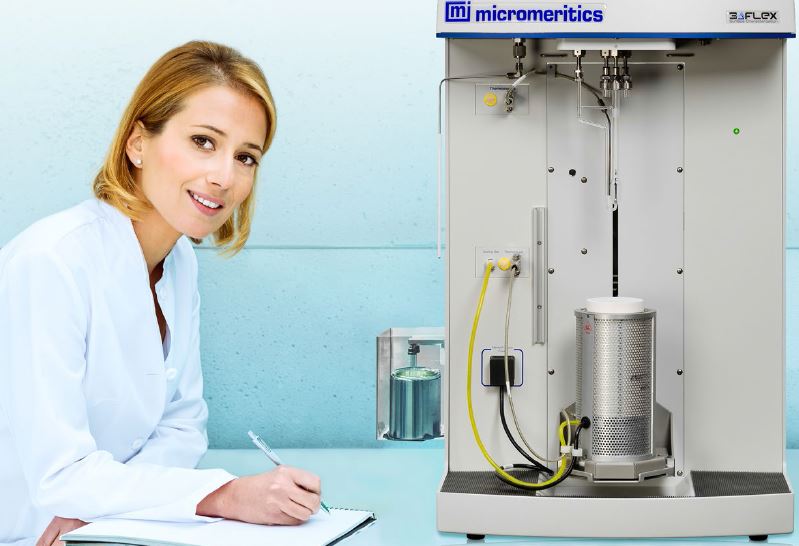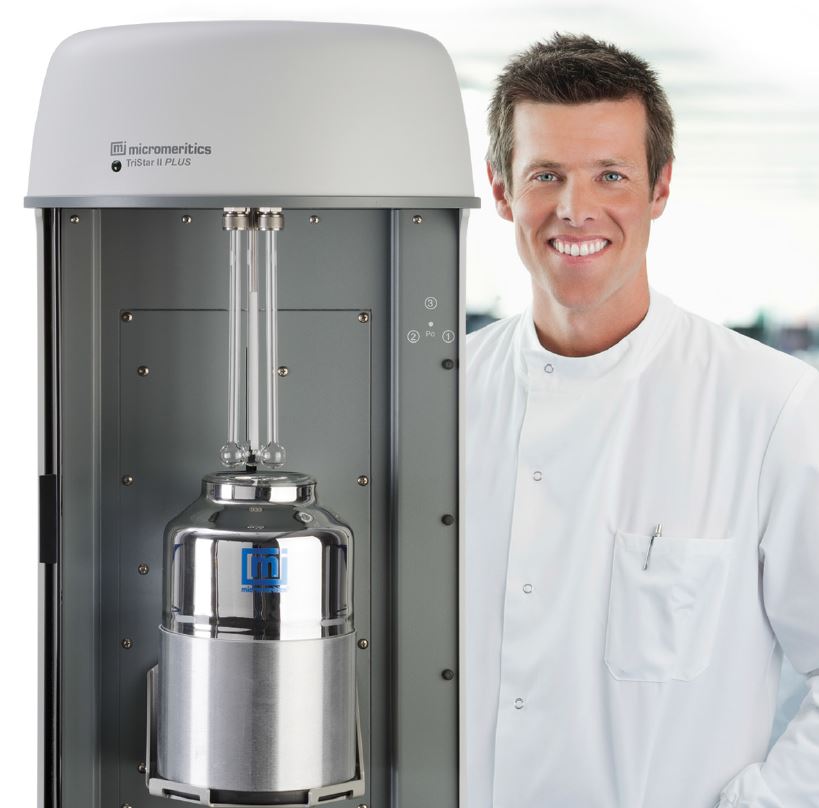ASAP 2020 Plus Surface Area and Porosimetry System
Micromeritics ASAP 2020 Plus provides high-quality surface area, porosity, and chemisorption isotherm data for materials analysis.



ASAP 2020 Plus Surface Area and Porosimetry System
Micromeritics ASAP 2020 Plus provides high-quality surface area, porosity, and chemisorption isotherm data for materials analysis.
| Manufacturer | Micromeritics |
|---|---|
| Product Series | Micromeritics ASAP |
| Measurement principle | Chemisorption, Physisorption |
| Application | Surface Area & Porosity |
| Pressure measurement range | 0 to 950 mmHg |
| Pressure measurement accuracy | > 0.15% of reading |
| Degas temp range | Ambient to 450 °C, 1 °C increments |
| Cryogen system capacity | 3-Liter Dewar, which provides up to 72 hours of unattended analysis |
Product Overview
The Micromeritics ASAP 2020 Plus integrates a variety of automated gas sorption techniques into a single, table top instrument to provide high-quality surface area, porosity, and chemisorption isotherm data for materials analysis.
The system can be configured to specific needs with the option of upgrading at a later date as analytical requirements change. Users can choose from low surface area, to heated vapor, to micropore capability, add a cryostat, an external detector, or configure the unit for enhanced chemical resistance when working with aggressive vapors.
Isothermal jackets are guaranteed for the life of the instrument and ensure a constant thermal profile along the full length of both the sample and saturation pressure (P0) tubes.
- BENEFITS
- APPLICATIONS
- CUSTOMER TESTIMONIAL
BENEFITS
- Two Independent vacuum systems that allow preparation and analysis to proceed concurrently
- Oil-free “dry” vacuum option to prevent oil contamination
- Two-station intelligent degas system for fully automated degassing with controlled heating time profiles
- Long-duration cryogen system for unattended analyses
- Twelve gas inlets that are automatically selectable to allow for automated selection of pretreatment, backfill, and analysis gases, and the ability to connect to a mass spectrometer
APPLICATIONS
![]() Pharmaceuticals: Surface area and porosity play major roles in the purification, processing, blending, tableting, and packaging of pharmaceutical products as well as their useful shelf life, dissolution rate, and bio-availability.
Pharmaceuticals: Surface area and porosity play major roles in the purification, processing, blending, tableting, and packaging of pharmaceutical products as well as their useful shelf life, dissolution rate, and bio-availability.
![]() Ceramics: Surface area and porosity affect the curing and bonding of greenware and influence strength, texture, appearance, and density of finished goods. The surface area of glazes and glass frits affects shrinkage, crazing, and crawling.
Ceramics: Surface area and porosity affect the curing and bonding of greenware and influence strength, texture, appearance, and density of finished goods. The surface area of glazes and glass frits affects shrinkage, crazing, and crawling.
![]() Adsorbents: Knowledge of surface area, total pore volume, and pore size distribution is important for quality control of industrial adsorbents and in the development of separation processes. Surface area and porosity characteristics affect the selectivity of an adsorbent.
Adsorbents: Knowledge of surface area, total pore volume, and pore size distribution is important for quality control of industrial adsorbents and in the development of separation processes. Surface area and porosity characteristics affect the selectivity of an adsorbent.
![]() Activated Carbons: Surface area and porosity must be optimized within narrow ranges to accomplish gasoline vapor recovery in automobiles, solvent recovery in painting operations, or pollution controls in wastewater management.
Activated Carbons: Surface area and porosity must be optimized within narrow ranges to accomplish gasoline vapor recovery in automobiles, solvent recovery in painting operations, or pollution controls in wastewater management.
![]() Carbon Black: The wear lifetime, traction, and performance of tires are related to the surface area of carbon blacks used in their production.
Carbon Black: The wear lifetime, traction, and performance of tires are related to the surface area of carbon blacks used in their production.
![]() Fuel Cells: Fuel cell electrodes require high surface area with controlled porosity to produce optimum power density.
Fuel Cells: Fuel cell electrodes require high surface area with controlled porosity to produce optimum power density.
![]() Catalysts: The active surface area and pore structure of catalysts influence production rates. Limiting the pore size allows only molecules of desired sizes to enter and exit, creating a selective catalyst that will produce primarily the desired product.
Catalysts: The active surface area and pore structure of catalysts influence production rates. Limiting the pore size allows only molecules of desired sizes to enter and exit, creating a selective catalyst that will produce primarily the desired product.
![]() Paints and Coatings: The surface area of a pigment or filler influences the gloss, texture, color, color saturation, brightness,solids content, and film adhesion properties. The porosity of a print media coating is important in offset printing where it affects blistering, ink receptivity, and ink holdout.
Paints and Coatings: The surface area of a pigment or filler influences the gloss, texture, color, color saturation, brightness,solids content, and film adhesion properties. The porosity of a print media coating is important in offset printing where it affects blistering, ink receptivity, and ink holdout.
![]() Projectile Propellant: The burn rate of propellants is a function of surface area too high a rate can be dangerous; too low a rate can cause malfunction and inaccuracy.
Projectile Propellant: The burn rate of propellants is a function of surface area too high a rate can be dangerous; too low a rate can cause malfunction and inaccuracy.
![]() Medical Implants: Controlling the porosity of artificial bone allows it to imitate real bone that the body will accept and allow tissue to be grown around it.
Medical Implants: Controlling the porosity of artificial bone allows it to imitate real bone that the body will accept and allow tissue to be grown around it.
![]() Electronics: By selecting high surface area material with carefully designed pore networks, manufacturers of super-capacitors can minimize the use of costly raw materials while providing more exposed surface area for storage of charge.
Electronics: By selecting high surface area material with carefully designed pore networks, manufacturers of super-capacitors can minimize the use of costly raw materials while providing more exposed surface area for storage of charge.
![]() Cosmetics: Surface area is often used by cosmetic manufacturers as a predictor of particle size when agglomeration tendencies of the fine powders make analysis with a particle-sizing instrument difficult.
Cosmetics: Surface area is often used by cosmetic manufacturers as a predictor of particle size when agglomeration tendencies of the fine powders make analysis with a particle-sizing instrument difficult.
![]() Aerospace: Surface area and porosity of heat shields and insulating materials affect weight and function.
Aerospace: Surface area and porosity of heat shields and insulating materials affect weight and function.
![]() Geoscience: Porosity is important in groundwater hydrology and petroleum exploration because it relates to the quantity of fluid that a structure can contain as well as how much effort will be required to extract it.
Geoscience: Porosity is important in groundwater hydrology and petroleum exploration because it relates to the quantity of fluid that a structure can contain as well as how much effort will be required to extract it.
![]() Nanotubes: Nanotube surface area and microporosity are used to predict the capacity of a material to store hydrogen.
Nanotubes: Nanotube surface area and microporosity are used to predict the capacity of a material to store hydrogen.
![]() More Applications:
More Applications:
- Adhesives
- Alloys
- Abrasives
- Carbonates
- Cements
- Clays
- Detergents
- Fibers
- Films
- Fertilizers
- Filters
- Glass
- Food Additives
- Graphite
- Minerals
- Paper
- Polishing Compounds
- Polymers
- Resins
- Soils and Sediments
CUSTOMER TESTIMONIAL
RUX Energy accelerating Australia’s hydrogen-powered future, shares their experiences using the Micromeritics ASAP system.
Product Enquiry
SPEAK TO OUR AUSTRALIAN AND NEW ZEALAND TEAM
If you would like to enquire about this product, fill out this form and one of our product specialists will contact you shortly.
If you need help in the operation or repair of an instrument then please contact the Customer Help Centre directly.
Please note, product enquiries are only applicable to Australia, New Zealand, Papua New Guinea and Fiji
Or call us instead at (02) 9541 3500




 02 9541 3500
02 9541 3500
